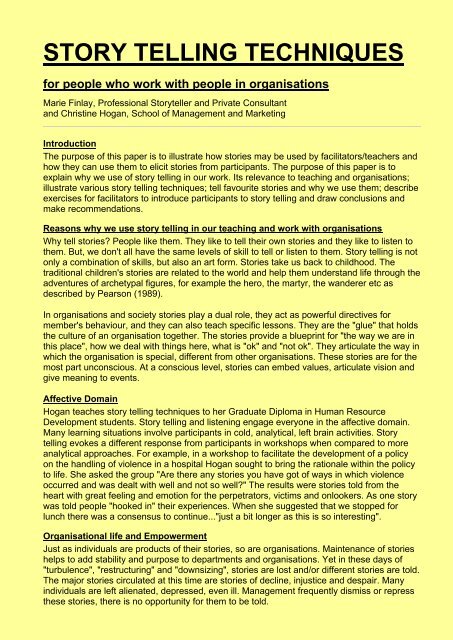HOW TO WRITE BETTER FAIRY TALES - DEAN AMORY
Complete course on writing Fairy Tales (aka Wonder Tales)
Complete course on writing Fairy Tales (aka Wonder Tales)
You also want an ePaper? Increase the reach of your titles
YUMPU automatically turns print PDFs into web optimized ePapers that Google loves.
S<strong>TO</strong>RY TELLING TECHNIQUES<br />
for people who work with people in organisations<br />
Marie Finlay, Professional Storyteller and Private Consultant<br />
and Christine Hogan, School of Management and Marketing<br />
Introduction<br />
The purpose of this paper is to illustrate how stories may be used by facilitators/teachers and<br />
how they can use them to elicit stories from participants. The purpose of this paper is to<br />
explain why we use of story telling in our work. Its relevance to teaching and organisations;<br />
illustrate various story telling techniques; tell favourite stories and why we use them; describe<br />
exercises for facilitators to introduce participants to story telling and draw conclusions and<br />
make recommendations.<br />
Reasons why we use story telling in our teaching and work with organisations<br />
Why tell stories? People like them. They like to tell their own stories and they like to listen to<br />
them. But, we don't all have the same levels of skill to tell or listen to them. Story telling is not<br />
only a combination of skills, but also an art form. Stories take us back to childhood. The<br />
traditional children's stories are related to the world and help them understand life through the<br />
adventures of archetypal figures, for example the hero, the martyr, the wanderer etc as<br />
described by Pearson (1989).<br />
In organisations and society stories play a dual role, they act as powerful directives for<br />
member's behaviour, and they can also teach specific lessons. They are the "glue" that holds<br />
the culture of an organisation together. The stories provide a blueprint for "the way we are in<br />
this place", how we deal with things here, what is "ok" and "not ok". They articulate the way in<br />
which the organisation is special, different from other organisations. These stories are for the<br />
most part unconscious. At a conscious level, stories can embed values, articulate vision and<br />
give meaning to events.<br />
Affective Domain<br />
Hogan teaches story telling techniques to her Graduate Diploma in Human Resource<br />
Development students. Story telling and listening engage everyone in the affective domain.<br />
Many learning situations involve participants in cold, analytical, left brain activities. Story<br />
telling evokes a different response from participants in workshops when compared to more<br />
analytical approaches. For example, in a workshop to facilitate the development of a policy<br />
on the handling of violence in a hospital Hogan sought to bring the rationale within the policy<br />
to life. She asked the group "Are there any stories you have got of ways in which violence<br />
occurred and was dealt with well and not so well?" The results were stories told from the<br />
heart with great feeling and emotion for the perpetrators, victims and onlookers. As one story<br />
was told people "hooked in" their experiences. When she suggested that we stopped for<br />
lunch there was a consensus to continue..."just a bit longer as this is so interesting".<br />
Organisational life and Empowerment<br />
Just as individuals are products of their stories, so are organisations. Maintenance of stories<br />
helps to add stability and purpose to departments and organisations. Yet in these days of<br />
"turbulence", "restructuring" and "downsizing", stories are lost and/or different stories are told.<br />
The major stories circulated at this time are stories of decline, injustice and despair. Many<br />
individuals are left alienated, depressed, even ill. Management frequently dismiss or repress<br />
these stories, there is no opportunity for them to be told.


















